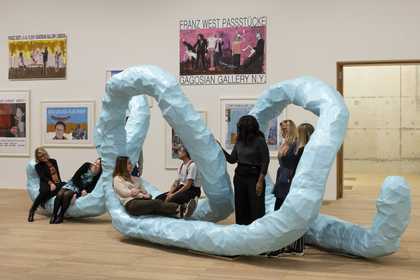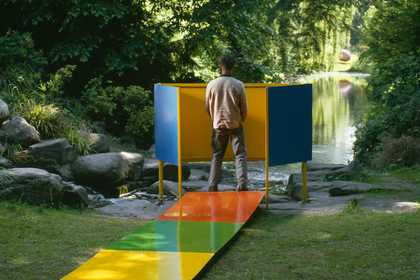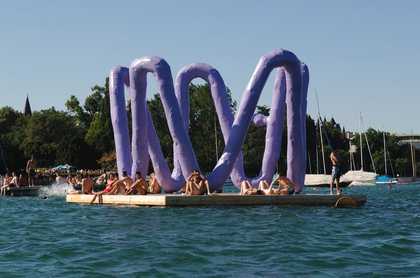
Franz West Corona 2006
Photo: Stefan Altenburger Photography, Zürich, courtesy Eva Presenhuber
Room 1
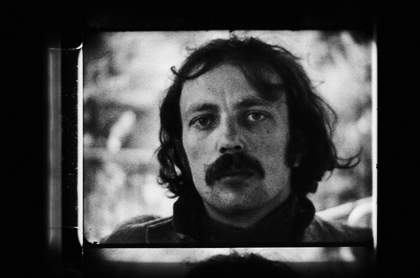
Friedl Kubelka
Graf Zokan (Franz West) 1969
Film, 16 mm, B/W, silent, 3 min
Courtesy Friedl Kubelka
Franz West
Franz West, who died in 2012, combined an irreverent and playful approach to sculpture, furniture and collage with an interest in philosophy, literature and music. He was fascinated by the work of other artists and collaborated with them in various ways.
In the mid-70s, West developed small sculptures (the Passstücke or Adaptives) which people could play with. These were some of the first interactive sculptures in twentieth-century art. By the mid-80s, he was showing ‘Legitimate Sculptures’ on pedestals. He began producing furniture, which he also saw as sculptures. In his work he often used materials associated with the kindergarten like papier mâché, incorporating empty alcohol bottles, and slathering on paint while on the telephone to friends.
West lived in Vienna and was very connected to its culture. The work of philosopher Ludwig Wittgenstein and Viennese experimental literature attracted him. So did the leisurely atmosphere of coffee houses and the legacy of psychoanalysis as conceived by Sigmund Freud, including the idea of reclining and talking. British artist Sarah Lucas was a friend of West’s, and they collaborated on several occasions. She has designed the pedestals, walls and barriers in this show – an example of how West remains so important for artists today.
ROOM 2
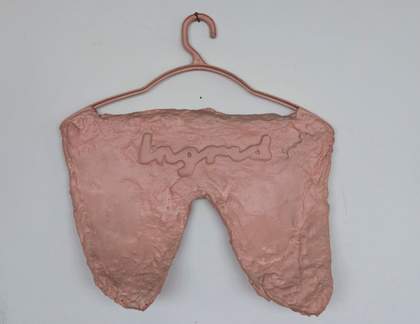
Franz West
Hängebusen Ingrid late 1970s
Polyester, varnish, cardboard and clothes hanger
45 ×41 ×11
Private collection. Ingrid Karl – Franz Koglmann
EARLY WORK
In the late 1960s West began making art, though for many years he was not taken very seriously. He spent days and nights in Viennese coffee houses and bars drinking heavily and experimenting with drugs. He got arrested twice and was regarded as an outsider.
West’s mother Emilie played an important role for him. She was a dentist from a middle-class Jewish family who often surrounded herself with artists. West referred to his first drawings as ‘Mutterkunst’ (mother art): art made to please his mother. In 1971, he took her maiden name West as
his surname.
As a self-taught artist, West picked up ideas from those around him. He worked briefly under the mentorship of Austrian artist Bruno Gironcoli. His half-brother Otto Kobalek, who was associated with the Wiener Gruppe of experimental writers, was another key influence.
West’s early works were informed by Viennese nightlife, mass media, and the different art movements in the city. The ornamental style of the German art movement Jugendstil fascinated him. He was more ambivalent about the Viennese Actionists, a group of slightly older artists whose performances were deliberately scandalous. As his collages here show, he took a different approach – less obviously shocking, but humorous and provocative.
Room 3

Franz West
Passstücke mit Box und Video 1996
Metal, plaster, plastic, wood, acrylic paint, fabric, monitor and video
Grässlin Collection, St. Georgen
PASSSTÜCKE
From 1973, West began to work on a group of sculptures made of papier mâché and plaster in various shapes and sizes. Many incorporated everyday objects such as paint brushes or even a radio. Viewers could handle them in any way they chose. People’s interaction with them was both playful and awkward.
For West, these works could function like extensions of the human body. He felt that the way people used them gave external form to their neuroses and desires. In 1980 when they were exhibited for the first time in Vienna, poet Reinhard Priessnitz called them Passstücke. West himself later found an English equivalent for this work, calling them Adaptives and suggesting that they adapt to viewers as viewers adapt to them.
West’s Adaptives became a significant component of the history of sculpture and performance. Friends and other artists were photographed and filmed using them, sometimes to classical music or jazz compositions by Franz Kogelmann. West incorporated many of these images in his collages and posters.
Today most of these pieces are too fragile to be handled. But in the installation Passstücke mit Box und Video 1996 there are four pieces you can pick up and play with.
Room 4
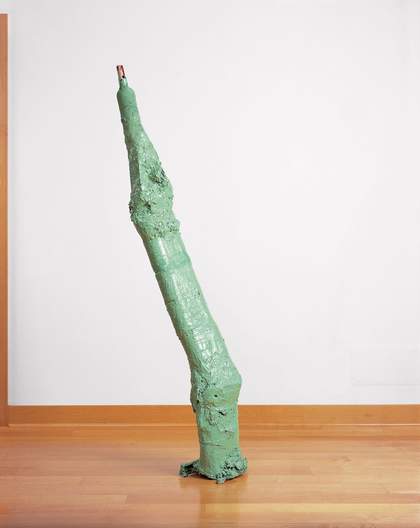
Franz West
Trunkenes Gebot 1988
Steel, wood, polyester, glass bottle and acrylic paint
Friedrich Christian Flick Collection im Hamburger Bahnhof, Berlin
LEGITIMATE SCULPTURE
In 1986 in Graz, Austria, West first exhibited what he called ‘Legitimate Sculptures’. The next year, his first institutional show in Vienna was held at the Secession gallery. Many of the works in this room were in these exhibitions. The Swiss curator Harald Szeemann, widely regarded as the most influential in Europe at this time, included Zitat 1985 – exhibited here – in an important travelling survey of new sculpture.
West used the cheeky title ‘Legitimate Sculpture’ because the viewer could no longer handle these objects. But the relationship to the work was still active, since the forms provoked imaginative reactions. Some sculptures resembled fragments of classical sculpture, others strange faces.
The main material for these works was papier mâché. West incorporated objects from daily life – a broom, bottles of alcohol he had consumed, or his childhood bed. West worked with writers to create texts accompanying these works, in the tradition of experimental Viennese literature. Instead of explaining the sculptures with traditional captions, they supplement them with often obscure references and ideas.
Most radical sculptors of the 1960s and 70s had ceased using pedestals and stands. When West began to use them, he took a playful approach. The breeze-block and MDF pedestals here are designed by Sarah Lucas specially for this exhibition.
Room 5
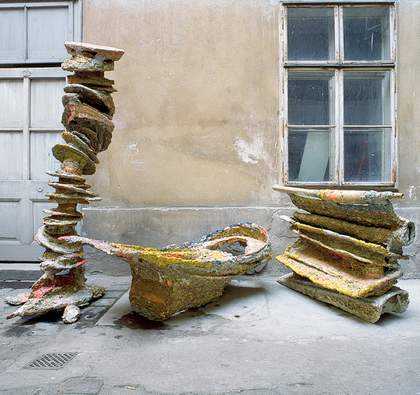
Franz West
Redundanz 1986
Papiermache
Museum moderner Kunst Stiftung Ludwig
COMBINATIONS
This room focuses on the works West made for solo shows at the Galerie Peter Pakesch in Vienna – Redundanz, in Autumn 1986 and Wegener Räume 2/6-5/6, exhibited two years later. Both exhibitions were structured by ideas of artworks as combinations of elements.
Redundanz was West’s most ambitious sculpture of the 1980s, an early example of combining parts into a single piece. Objects were coated with papier mâché and painted. Some are recognisable, like the stack of hats; others not. West worked with Austrian art critic Georg Schöllhammer and artist Rudolf Polanszky to create a text. Deliberately dense, it concerns the difficult relationship of language and art.
In 1979, West showed collages in Frankfurt with German artist Jürgen Wegner and sold them to him afterwards.
Returning to Frankfurt in 1988, he bought back the works. He developed an environment in which old and new pieces could be combined. Wegener Räume 2/6-5/6 combines four spaces, and in each, collages, objects, furniture come together with pedestals, labels and screen-like walls. Wegener Räume 2/6-5/6 was West’s first installation, and the first time he played with the language of display. In a single piece, he examined and took apart the conventions of how private collectors and museums exhibit collections.
In addition, the title refers not just to Wegner but sets up an allusion to the nineteenth-century German polar scientist Alfred Wegener
Room 6
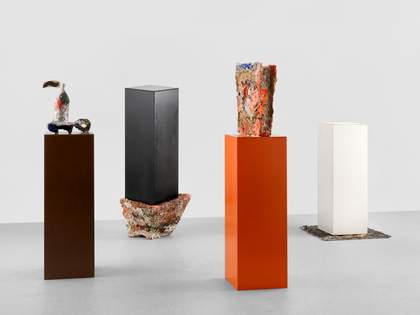
Franz West, Herbert Brandl born, Otto Zitko born and Heimo Zobernig
Untitled 1988
Wood, papier mâché, paint
Hauser & Wirth Collection, Switzerland
COLLABORATIONS
Early on, West was unsure about how to use colour with sculpture. He sometimes handed over objects to painterfriends to paint. But the result was considered his alone. In the late 1980s West began a series of proper collaborations, co-authored and shown in jointly credited exhibitions. He collaborated with three younger Viennese artists also associated with the Galerie Peter Pakesch: Herbert Brandl, Otto Zitko and Heimo Zobernig. West and Brandl made shows together in Vienna, Turin and Frankfurt. The surfaces of some of the works resemble Brandl’s own atmospheric and expressive paintings. In Frucht, however, Brandl’s spots on one side play up the title’s reference to fruit.
West was interested in Zobernig’s approach to sculpture after American minimalism, a form of reduced abstract art developed in the 1960s. His monoliths looked like minimal sculpture but were made cheaply with cardboard. Zobernig also developed a colour scheme different from West’s, based on tones he associated with offices and institutions.
In 1988, West made a series of sculptures painted by Brandl and Zitko, and combined them with four sculptures by Zobernig, playing with the relationship of object and pedestal. Collaboration enabled West to think through how an artwork could bring together contradictory ideas. In the mid-80s, while many critics were still arguing for a single line of art history, and a succession of distinct approaches to sculpture, West’s collaborations incorporated difference.
Room 7
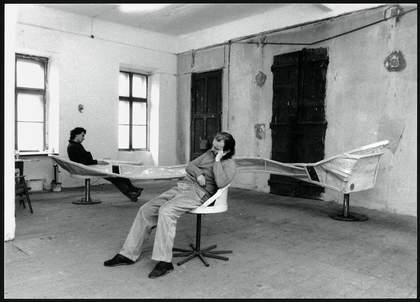
Franz West Eo Ipso 1987 (in the artist’s studio). Iron and paint, 2 parts: 118×546×115, 83×57×52. MAK – Österreichisches Museum für angewandte Kunst /Gegenwartskunst, Vienna
FURNITURE
In the mid-1980s West began to make furniture works. Unlike many recent artists including Joseph Beuys, Joseph Kosuth and Richard Artschwager, West wanted to make work that was functional – art and furniture at the same time. He saw them as an extension of his early work and said: ‘A chair is an everyday Passstück’. His furniture works are also his response to traditional Viennese monuments with enthroned emperors.
In 1987 West made Eo Ipso for a survey of sculpture in Münster, Germany, using his mother’s old washing machine painted a sickly green reminiscent of hospital corridors. Eo Ipso put its three users in an awkward position – joined by the sculpture but too far from each other to speak comfortably.
With his friend Mathis Esterhazy, West made chairs out of scrap metal. They showed them in 1989 at the Museum Haus Lange in Krefeld, Germany, elevated on pedestals, as were visitors who sat on them. Instead of cushions, newspaper pages were placed on some seats. West used the furniture to cultivate an image of idleness. He staged himself lounging on them, showing that good art can come from not working, rest, even boredom.
Room 8
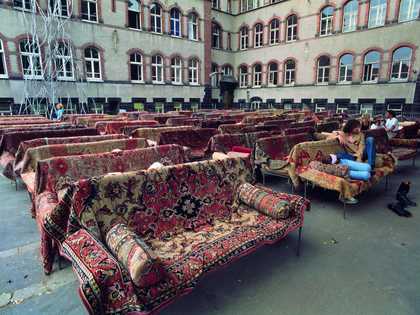
Franz West Auditorium 1992
(documenta IX, Kassel, 1992) 72 divans with cushions, iron and construction steel covered in carpet
Centre national des arts plastiques
On loan to Centre Pompidou, Musée national d’art moderne, Paris
DOCUMENTA AND BEYOND
By the early 1990s, West finally enjoyed greater visibility. He exhibited in several European museums, and at PS1 in New York in 1989. In 1990, he represented Austria at the Venice Biennale. In 1992, curator Jan Hoet invited him to participate in documenta, an international survey which takes place in Kassel, Germany every five years. West contributed two major works. Auditorium – reduced and reconfigured here – was 72 divans covered in old carpets like those draped over Freud’s consulting room couch. It was a sculpture where people could meet, talk about the other works in documenta, relax and think. Eight Lemurheads, four of which are here, were also shown.
These sculptures resemble eyeless monsters with cavities for mouths: West said the shapes came to him when finding faces in his bedsheets after waking up with hangovers. In the 1990s West began to collect and combine framed works by artist friends and to display them in scenarios with his furniture and sculptures. He collaborated with Austrian filmmaker Bernard Riff on various videos. Two are shown here in front of a picture of Warum ist etwas und nicht nichts, West’s first major Outdoor Sculpture, a pink blob bizarrely deposited on a roadside in rural Austria in 1997.
Room 9
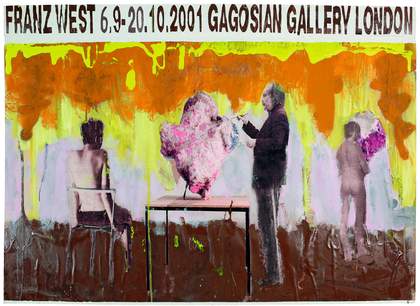
Franz West
Plakatentwurf (Gagosian Gallery, London) 2001
Acrylic paint and collage on cardboard
Private Collection, Gernot Schauer
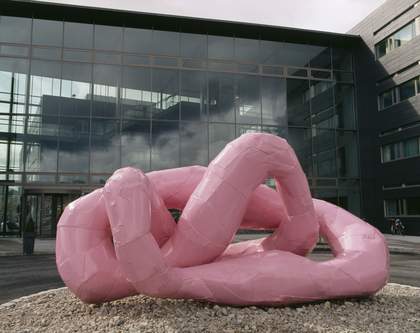
Franz West
Rrose/Drama 2001
Lacquered aluminium
Telenor Art Collection
INTO THE 2000s
Into the 2000s, West was producing many kinds of work at once. In one studio, he continued to prepare papier mâché from old telephone books and build large sculptures. He would cover them in paint before arranging them on makeshift pedestals fashioned from old furniture and other objects.
In another studio, he produced his Outdoor Sculptures. These were mainly made from sheets of aluminium, bent over an internal structure, and welded together. The joins were always visible. Later he used fibreglass and the adhesive, epoxy resin. The Outdoor Sculptures were always monochrome, and West tended to use gaudy colours. Pinks and blues recur: West once said he got them from children’s pyjamas.
Some Outdoor Sculptures were based on doodles like Schlieren 2010 here; others resembled turds or phalluses or twisted intestines, like Rrose/Drama 2001 outside. West saw them as an alternative to pompous public sculptures. Sometimes he included Outdoor Sculptures in his indoor exhibitions.
West showed at major museums and large galleries, and would always produce collages and posters to accompany his exhibitions. He loved to combine photographic images with paint, and to use kitschy and crass typography. In this way, he refused the elegant design so often used to brand art institutions.
In 2011, the year he won the prestigious Golden Lion award at the Venice Biennale, West also had his last solo gallery show in Vienna. Epiphanie an Stühlen 2011 was a characteristically irreverent work which promises a moment of sudden revelation to its seated viewer.
Room 10
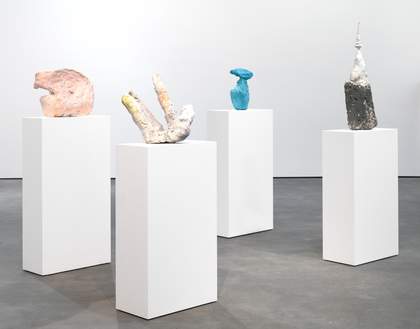
Franz West
2 to 2 (do too 2 [too do 2 {to do two}] ) 1994
Papier mâché, paint, gauze, gesso, metal
and plastic, 4 bookshelf pedestals, books
Private collection. Courtesy David Zwirner, New York/London/Hong Kong
A FRANZ WEST LIVING ROOM
This room includes models for the Outdoor Sculptures in cases made by Viennese artist Rudolf Polanzsky. Sisyphos V 2002 is a large papier mâché sculpture previously owned by Cy Twombly, an American artist West admired, and for whom he once composed an ‘Art Opera’. Another sculpture is presented on a pedestal West made to look like a block of Emmental cheese.
In the rest of the space, we have created a kind of Franz West living room, recalling the ways West broke with institutional rules and conventions of exhibiting art, and his desire to overcome the separation of art and life. The living room centres on 2 to 2 (do too 2 [too do 2 {to do two}]) 1994. Initially West made large pedestals for the small papier mâché sculptures but then cut them down and turned them into bookshelves which he filled with philosophy books. Copies of these books are presented on another of his bookshelves, and you can relax on the divans to read them next to his Grosse Lampe 2010.
You can also watch ENERGY DAIRIES 2010, a film by Julian Simmons, a response to a talk by West, Sarah Lucas and Austrian artist Andreas Reiter Raabe, with musical accompaniment (and interruptions) by Philipp Quehenberger at the Royal Institution in London. Between 2010 and 2012 Reiter Raabe collaborated with West on a series of hanging lamps that are shown just outside.

